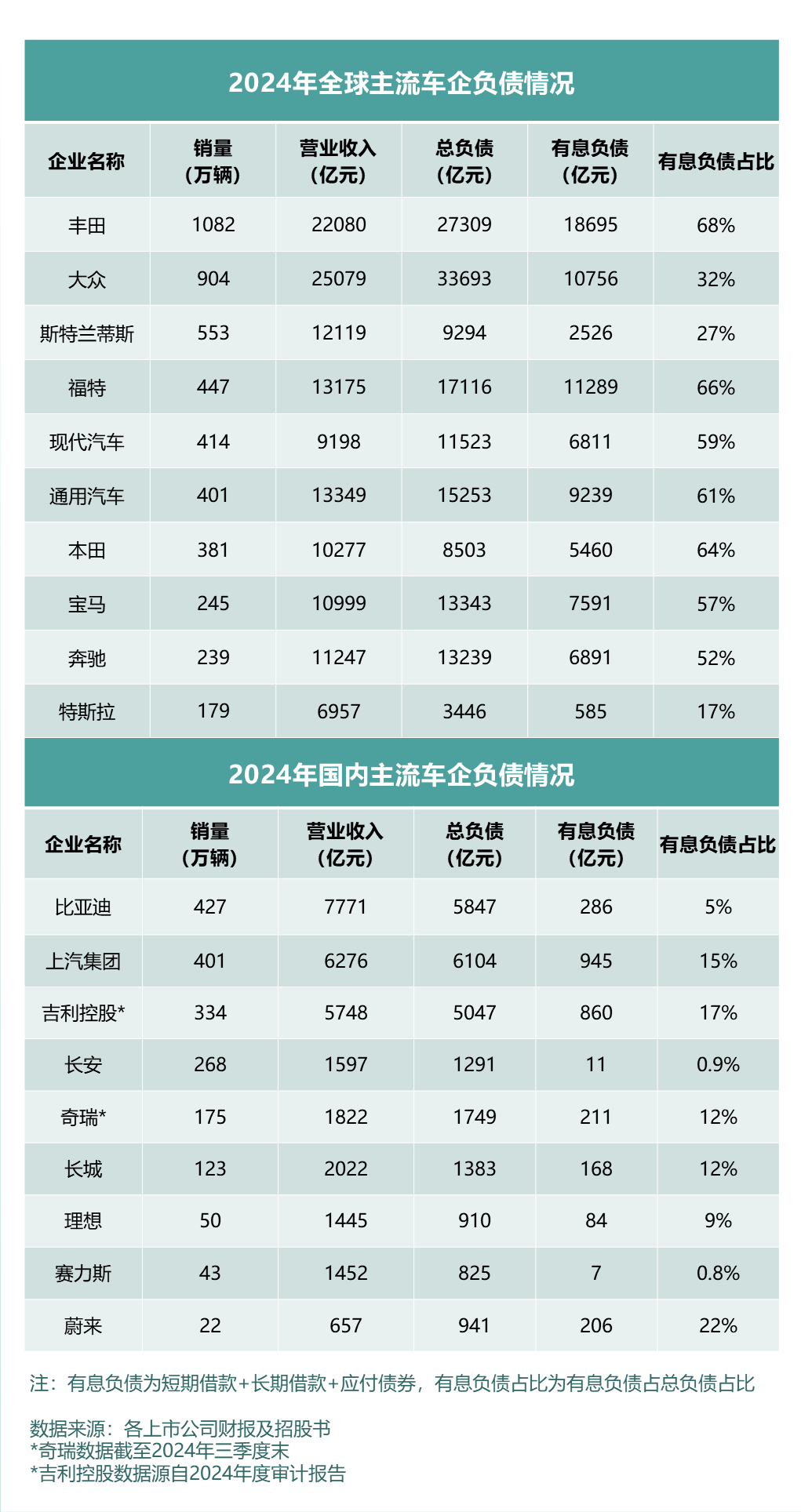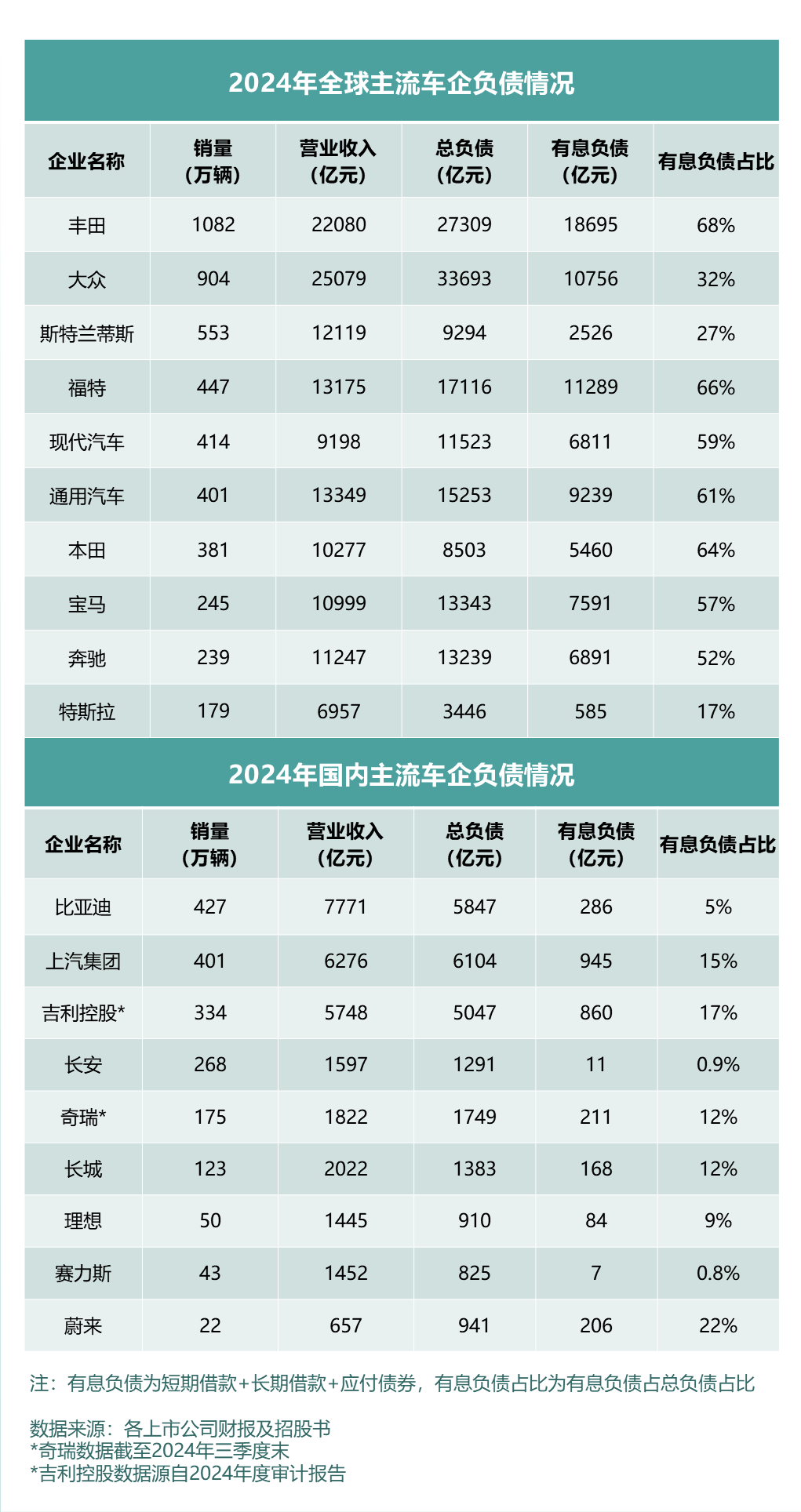
In recent years, with the intensification of competition, new car-making forces have faced a wave of bankruptcies. Their high debts due to poor management are impressive. The high debt and high debt ratio problems in the automotive industry have become the focus of attention for a while.
The debt ratio refers to the proportion of a company's total liabilities to its total assets. The debt ratios of different industries vary greatly due to industry characteristics, capital needs and operating models. For traditional manufacturing industries, a debt-to-asset ratio of 40%-60% is generally considered to be at a normal level. However, in the automotive industry, summarizing the financial report data of major global automakers in the past two years, it is not difficult to find that the debt-to-asset ratios of mainstream domestic and foreign automakers are generally above 60%, and the debt ratios of some automakers have exceeded 80% in recent years.
The total debt of the world's leading automakers is generally high, and they are more dependent on interest-bearing debt.
Let’s first look at total liabilities. Generally speaking, the larger the company and the higher its revenue, the higher its total liabilities.
It can also be seen from the financial reports of the past two years that the total debt of the world's leading automakers is generally high. As of the end of 2024, Volkswagen Group's revenue was 2.5 trillion yuan, and its total debt reached 3.4 trillion yuan, which was 136% of its revenue in the same period; Toyota's revenue was 2.2 trillion yuan, and its total debt reached 2.7 trillion yuan, which was 123% of its revenue in the same period; Ford's revenue was 1.3 trillion yuan, and its total debt reached 1.7 trillion yuan, which was 131% of its revenue in the same period. In addition, the total debts of General Motors, BMW, Mercedes-Benz, and Hyundai Motor are also over one trillion yuan.
Compared with multinational automakers, the total debt of domestic mainstream automakers is relatively low. For example, BYD's total revenue in 2024 was 777.1 billion yuan, and its total debt was 584.7 billion yuan, accounting for 75% of its revenue in the same period.
Corporate debt is divided into two categories: interest-free debt and interest-bearing debt. In comparison, interest-bearing debt is a more critical financial indicator. Interest-bearing debt refers to the interest that a company needs to pay when it borrows money from financial institutions and bonds issued in the capital market. If the pressure to repay the principal and interest is too great, the company may fall into a liquidity crisis, so it can better reflect the company's real debt pressure.
In general, the world's leading automakers are more dependent on interest-bearing debt. In 2024, Toyota, Volkswagen, and Ford's interest-bearing debt will all be above 1 trillion yuan, of which Toyota's interest-bearing debt accounts for 68% of total debt; Volkswagen Group's interest-bearing debt accounts for 32% of total debt; and Ford's interest-bearing debt accounts for 66% of total debt.
In comparison, the interest-bearing debt ratio of mainstream domestic automakers is very low. In 2024, BYD's interest-bearing debt will be about 28.6 billion yuan, accounting for only 5% of total debt.

Look at the debt ratio dialectically: reasonable debt can increase shareholder returns
So why does the automotive industry have a high debt ratio? Will it be fatal to companies? A consensus view is that the high debt ratio of the automotive manufacturing industry is related to its asset-intensive industry characteristics. In particular, the current automotive industry is in the process of electrification and intelligent transformation, and automakers inevitably need huge investments and R&D inputs.
Looking at both China and foreign markets, the debt ratio of some automakers has exceeded 80% in 2024. For example, in 2024, Ford's debt ratio is 84.27%; NIO's debt ratio is 87.45%; and SERES's debt ratio is 87.38%.
As an old traditional car company, Ford's high debt ratio shows that it is facing tremendous pressure for transformation. The profits of its fuel vehicle business have declined, and its electric vehicle business has not yet formed economies of scale. Revenue growth is not enough to cover interest, which is an important factor in its high debt ratio.
High debt ratios are more common in new energy car companies because they are in the expansion stage and need to invest a lot of money in R&D, sales network and charging facility construction. Especially for NIO, the construction of battery swap stations requires a lot of upfront investment and low asset turnover, which further increases debt.
In addition to the reasons mentioned above, the level of debt ratio is also related to the financial strategy adopted by the company. Some companies may prefer debt financing rather than equity financing to avoid equity dilution. In addition, rising interest rates will also lead to changes in financing costs.
The level of debt ratio is actually a double-edged sword and needs to be viewed dialectically. During a period of rapid expansion, some companies may actively increase debt to gain a competitive advantage.
The larger the scale of the car company, the higher the revenue, and the larger the volume of external procurement and cooperation. Reflected in the financial report, the greater the company's revenue, the more accounts payable (supplier payments that have not yet been paid). However, accounts payable act as a short-term capital lubricant, and if properly managed, they can optimize their own cash flow. Especially during the expansion period, car companies will choose to extend the payment period to use the funds for R&D, production or investment in new technologies, such as solid-state batteries and autonomous driving.
From BYD's perspective, in the first quarter of 2025, its debt ratio has dropped to 70.7%, and the debt ratio has dropped by nearly seven percentage points in the past six months. BYD's debt ratio is likely to drop to the "6" digit this year. Looking at the financial report, we can see that BYD's debt ratio decline is not only related to its accounts payable management, but also by improving profits to increase assets and thus drive down its debt ratio. Relatively speaking, it is relatively stable.
Sometimes, deliberately reducing debt may also limit investment in new technologies. For example, Toyota's debt ratio has not been high for a long time, which is related to the conservative strategy it has adopted. However, insufficient investment in electrification research and development has also led to its current lagging behind in the market share of pure electric vehicles.
at last
In addition to cash flow and operating profit, institutions often use debt ratio as an important indicator when evaluating the financial health risk of enterprises and rating them. The debt ratio actually reflects whether the enterprise can find a balance between survival and expansion. Reasonable debt can not only increase shareholder returns, but also enable the enterprise itself to maintain stability and long-term development.